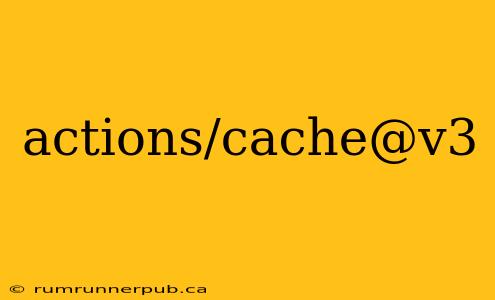GitHub Actions workflows can quickly become slow and expensive if they repeatedly download and build dependencies. This is where the actions/cache@v3 action shines. It allows you to cache the results of long-running processes, significantly reducing workflow execution time and cost. This article will delve into how to effectively use this crucial action, drawing on insights from Stack Overflow and providing practical examples.
Understanding actions/cache@v3
The core function of actions/cache@v3 is simple: it stores and retrieves artifacts from a cache. This cache resides within GitHub's infrastructure and is specific to your repository, workflow, and a defined key. If a matching key exists in the cache, the cached artifact is used; otherwise, the workflow executes the specified steps, caches the result, and future runs can leverage the cached version.
Key Concepts:
key: A string that uniquely identifies the cache entry. This is crucial; a poorly chosen key can lead to cache misses. The key often incorporates information like dependency versions or checksums. A bad key will lead to wasted caching opportunities.path: The file path(s) to cache. This should encompass all the files necessary for your later workflow steps.restore-keys: Fallback keys to use if the primarykeyis not found. This is crucial for handling minor changes that shouldn't invalidate the cache.
Common Stack Overflow Questions and Answers (with Analysis)
Let's address some frequently asked questions about actions/cache@v3 found on Stack Overflow, enriching the answers with added context.
1. How to cache Node.js dependencies?
Many Stack Overflow posts grapple with caching node_modules. A common solution, adapted from various answers and incorporating best practices, looks like this:
- name: Cache node modules
uses: actions/cache@v3
with:
path: ~/.npm
key: ${{ runner.os }}-node-${{ hashFiles('**/package-lock.json') }}
restore-keys: |
${{ runner.os }}-node-
Analysis: This uses the operating system and a hash of package-lock.json to create the cache key. The package-lock.json file ensures that only identical dependency sets are cached. The restore-keys provides a fallback, useful if only minor changes occur in your dependencies. This ensures that even with minor updates, the cache can still be partially used. Consider adding **/yarn.lock if you're using Yarn.
2. Handling Cache Misses
A frequent concern is dealing with cache misses. A Stack Overflow user might ask about troubleshooting why their cache isn't working.
Analysis: Cache misses usually stem from incorrect key generation or changes in the cached files. Ensure your key accurately reflects the state of your dependencies. Adding more specific information to the key (e.g., specific library versions) might be necessary for complex projects, but it will also lead to more cache misses. The restore-keys are crucial here, as they can help mitigate the impact of minor updates. Proper logging of the cache hit/miss status within your workflow is crucial for debugging.
3. Caching Large Files Efficiently
Caching extremely large files can impact performance.
Analysis: For large datasets, consider using alternative solutions like GitHub Packages or storing the data in a cloud storage service like AWS S3. Directly caching massive files can lead to lengthy cache retrieval times. If you must cache large files, ensure you have sufficient resources on your runner and consider strategies like splitting the data into smaller, more manageable chunks.
Best Practices for actions/cache@v3
- Use descriptive keys: Ensure keys accurately reflect your dependencies' state.
- Leverage
restore-keys: Minimize the impact of minor changes. - Monitor cache hits and misses: Track your workflow performance to identify optimization opportunities.
- Choose the right caching strategy: Select the strategy that best fits your project's needs and complexity.
- Keep your cached artifacts as small and efficient as possible.
By thoughtfully using actions/cache@v3 and applying these best practices, you can drastically reduce your GitHub Actions workflow execution times, lowering costs and improving overall developer productivity. Remember, the key is in crafting robust and meaningful cache keys. Proper usage ensures that your caching strategy remains effective and efficient.
